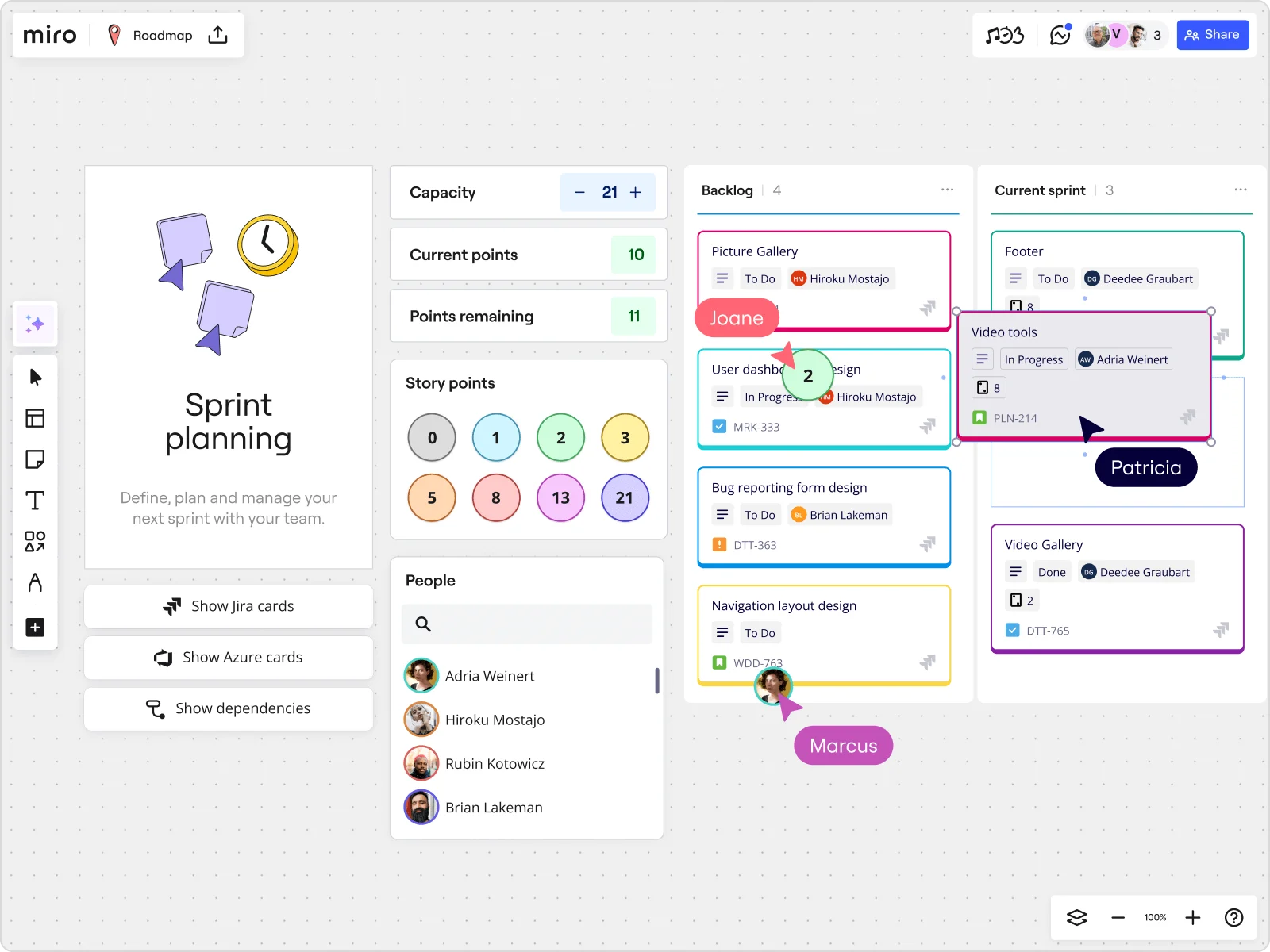
What is velocity in Agile? The ultimate guide

Summary
In this guide, you will learn:
What Agile velocity means and why it's important
How to calculate velocity by summing completed story points
Velocity's role in setting goals and aligning with objectives
How to track velocity trends over sprints for capacity insights
Common misconceptions about velocity (not a success metric to maximize)
Challenges in maintaining consistent velocity, especially for remote teams
Try Miro now
Join thousands of teams using Miro to do their best work yet.
Velocity plays an important role in successful Agile workflows. But what exactly is velocity in Agile and how do you measure it? This guide covers everything you need to know — including how to calculate velocity in Agile, best practices, and how to get started in Miro.
Let's dive in.
What is velocity in Agile?
Agile velocity tells you how much work a team accomplishes in a sprint. Typically, it's calculated by adding up all the completed story points at the end of the sprint.
Every team has its unique velocity, which acts as a baseline for its capacity. Remember, it's not about comparing teams; it's more about tracking your progress over time.
For product teams, understanding velocity is key to setting realistic goals. It's about syncing team output with larger strategic goals. This clarity helps teams steadily work toward their targets.
Why is velocity important?
Now that we've covered the Agile velocity definition, let's talk about why it's so important. Agile velocity gives you a clear picture of how work is progressing and what you might be able to achieve going forward.
With velocity, teams can set realistic timelines, avoiding burnout while keeping development sustainable. Trying to set expectations without considering velocity can lead to uncertainty about outcomes.
On top of that, velocity helps align everyone involved in the project on delivery capacity. It sets the stage for understanding how fast a team can work without sacrificing quality. It's not about rushing --- it's about being consistent and reliable.
Velocity for predicting project timelines
Velocity also comes in handy for creating realistic project timelines. By analyzing trends in velocity, teams can confidently predict completion dates. This insight is super valuable for managing stakeholder expectations.
Project managers can leverage velocity to foresee any potential roadblocks. When you understand the lay of the land with velocity, making real-time adjustments becomes much more manageable. This proactive approach helps teams keep projects on track, smoothly.
Velocity for Sprint planning
When it comes to sprint planning, having accurate velocity metrics is essential. Knowing your team's velocity helps you set sprint goals that match your actual capacity — so you don't overcommit to tasks.
Using Sprint velocity means you can make data-driven decisions about what's achievable. This kind of clarity boosts confidence and makes the whole planning process a lot less stressful.

How to calculate velocity in Agile
Calculating velocity is easy and super important for successful Agile practices. Here are a few simple steps you can follow to get accurate sprint planning:
1. Complete the Sprint
Make sure the sprint cycle is wrapped up and you have completed tasks. Aim to have all tasks finalized by the end of the sprint.
2. Gather data
Collect all the completed story points from the sprint. Documentation is crucial here, so record each task's points and ensure everything is accounted for.
3. Sum up
Add all the completed story points together to find your velocity. Use a simple spreadsheet or Agile project management tools to keep track of these numbers consistently.
4. Review consistency
Compare with past sprints to spot any trends. This will help you understand your team's performance and adjust future planning accordingly.

Best practices for velocity in Agile
Optimizing velocity goes beyond mere calculations; it's essential to understand and apply the data effectively. Here are some essential practices to keep velocity working in your favor:
Set realistic goals
Establish objectives based on your team's velocity to ensure that workloads are manageable and achievable. This can help you manage your workload better and prevent stress.
Regularly review velocity trends
Hold regular team meetings to review velocity trends. This encourages open communication and keeps everyone informed about progress and areas for improvement.
Use velocity data
Incorporate velocity data when refining your backlog. Use it to inform your decisions and ensure your team focuses on the most impactful tasks.
Stay flexible
Be ready to adjust your plans based on velocity insights. Agile is all about being adaptable, and responding to changes will keep your team on track.
Run Agile team events in Miro
Ready to take your Agile team events to the next level? Miro's intuitive and powerful Agile tools make it easy for teams to come together and create their best work. Seamlessly run everything from Sprint planning to retrospectives — and more.
Sign up to get started.
Author: Miro Team
Last update: October 2, 2025